Having just booked their place in the UEFA Europa Conference League quarter-finals, where they’ll face a tough test versus in-form EPL side Aston Villa, Lille will be on something of a high entering their Ligue 1 clash with high-flying Brest this weekend.
The only side other than PSG to win any of the last six French top-flight titles, Lille have been one of France’s most successful sides over the past half-decade or so, winning one league title in that time and finishing in the top half of the league each season.
During this period, Lille have undergone significant changes at boardroom level, with President Gérard López leaving the club in December 2020, midway through their title-winning campaign, as Lille were sold to Luxembourg-based investment fund Merlyn Partners SCSP at a time when they were riddled with financial debt, amplified massively by the catastrophic collapse of Ligue 1 television deal with Mediapro.
The fact Lille went on to win Ligue 1 that season is a credit to Christophe Galtier, Lille’s technical department and backroom staff, along with, of course, the players in that squad who managed to block out the noise surrounding the club and persevere with their jobs on the pitch to give the fans a memorable victory.
However, Lille’s overall landing following the crash that was the collapse of Ligue 1’s multi-million euro TV deal back in 2021 is a greater credit to the intelligent way in which the club has been led through the storm.
This team analysis piece will include aspects of data analysis, tactical analysis, and snippets from interviews with key figures inside the club applied to the context of what they have actually done over the last few years to paint a picture of how and why Lille are being run in such an admirable way, with effective communication and harmony across all facets of the club at the core of its success.
Recruitment and player sales
To start with, we’re going to focus on Lille’s transfer business in recent years and the role it’s played in both the club’s financial recovery and their success on the pitch.
Ex-player Franck Béria has been Lille’s ‘Director of Professional Football’ since 2017, and he worked closely with Luís Campos in the role of Sporting Director from 2017 to 2020 when the renowned Portuguese transfer maestro departed along with López when Les Dogues were sold to Merlyn Partners SCSP.
The departure of Campos, currently PSG’s strategic advisor who’s really become a highly valued name in world football since playing a vital role in Monaco’s success in the mid-2010s — including a Ligue 1 title — was seen as a big blow for Lille.
However, he was replaced in some capacity alongside Béria by Sylvain Armand, who became the Hauts-de-France club’s ‘Sports Coordinator’ shortly after Campos’ departure, and with the exception of 2021/22, Les Dogues have thus far continued to hit their targets and remain the envy of many clubs in Europe’s top-five leagues with regard to the way in which they’ve been run, finding an equilibrium between financial stability and sustainability, and on-the-pitch success.
In an interview with Lille’s official website following his arrival in January 2021, Armand described his role as one that: “consists of being the link between the players, the coach and the president” — a facilitator of communication and synchronisation of sorts responsible for ensuring clarity and alignment between different departments at all times as well as overseeing the successful implementation of finer details in the day to day running of a club, with Armand giving the example of certain “pre-match protocols” he takes on.
Armand’s past as a player who lined up alongside the likes of Zlatan Ibrahimović and Thiago Silva will be valuable experience for him when it comes to communicating with and understanding the squad. The fact that he played under a wide range of managers, including Carlo Ancelotti, will give him some insight into the mindset and concerns of the coach—another vital aspect of his role, as detailed.
The ex-PSG, Rennes, Nantes and Clermont Foot full-back went on to get a General Manager diploma from CDES following the completion of his playing career which focused on “economic, legal and managerial issues encountered within professional clubs and dedicated bodies”, per the college website, adding more tools to Armand’s belt for this current role he occupies in relation to management — including both the skills of managing down and managing up — which will have come in absolutely crucial in all aspects of his job at Lille, including dealing with the President and shareholders interests.
A big concern for the new owners on arriving at Lille will have been getting them in a more financially stable position; their transfer dealings during this period have gone a long way to achieving that.
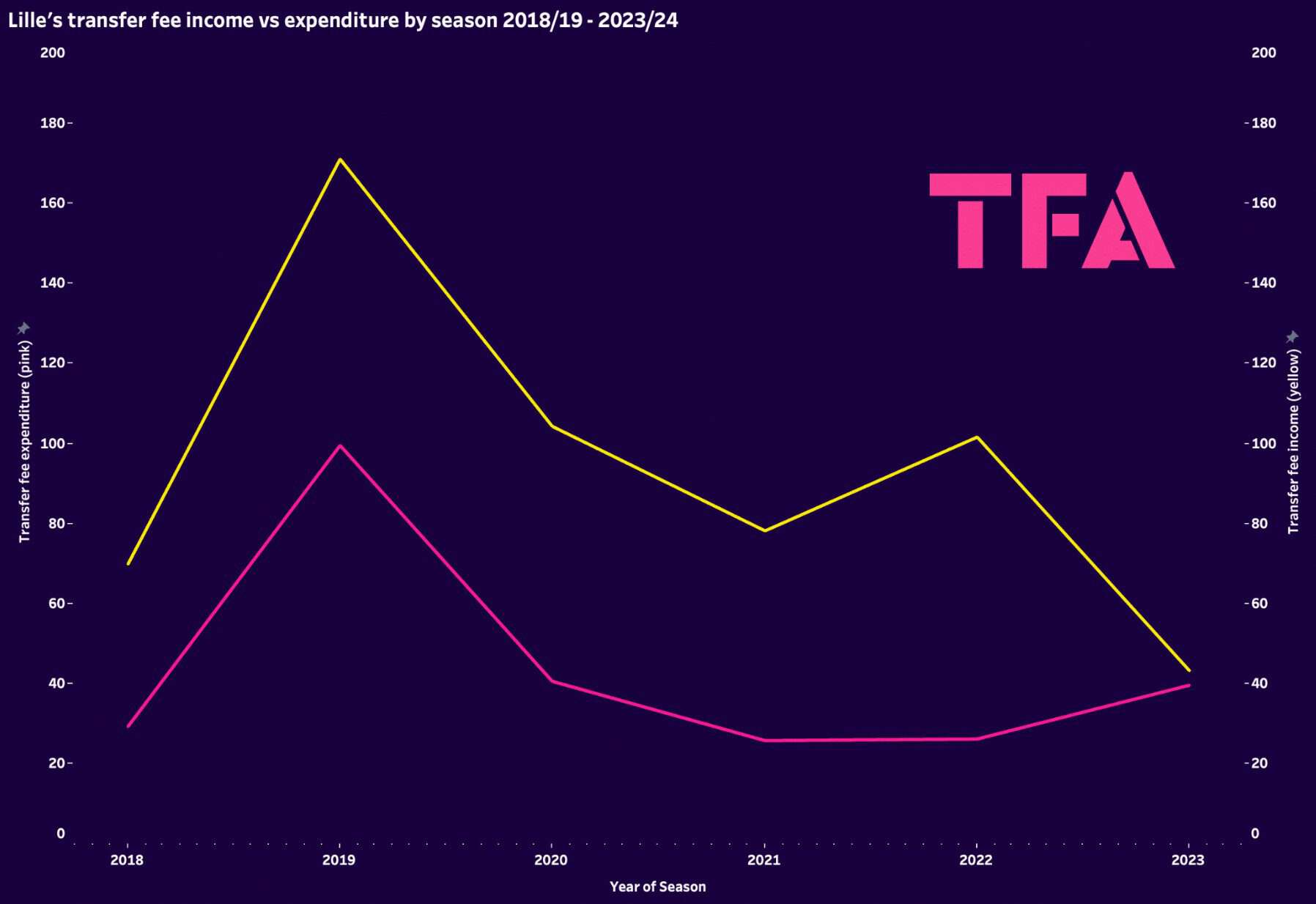
Over the last six seasons, including the current one, Lille have made a €307.55m profit on transfer fees—€131.6m of that has been made in the last three seasons since the club’s sale and the aforementioned backroom changes took place.
Lille have been the most profitable club in the world when it comes to non-academy players signed and transferred during the last decade, according to statistics from CIES Football Observatory — a stark contrast to Barcelona, who have made the most losses in that area during the same period.
A key aspect of Lille’s consistent top-flight success in France is their transfer sustainability. They consistently recruit well, buying promising talents for relatively cheap and selling them on for nice profits down the line after giving them a chance to shine in the first-team setup.
At the moment, the likes of Bafodé Diakité (signed for €3m, currently valued at €15m by Transfermarkt), Alexsandro (signed for €2m, currently valued at €7m by Transfermarkt), Edon Zhegrova (signed for €7m, currently valued at €10m by Transfermarkt) and Tiago Santos (signed for €6.5m, currently valued at €8m by Transfermarkt) — all signed during the current ownership — are in the midst of that process.
Youth development
Lille don’t want to just sign players made elsewhere; they want to create their own homegrown stars and give them a chance to shine as well. This will boost their finances even further with cost-savings, promote the sustainability of the club in the long term via the natural resource that is their young talent, and further boost their reputation as a place for young players to learn and improve themselves.
Les Dogues have a good reputation for youth development, with the likes of Eden Hazard and Benjamin Pavard among those to have been produced in Hauts-de-France.
In the current squad, first-team regulars from the youth academy include 22-year-old goalkeeper Lucas Chevalier (valued at €18m by Transfermarkt) and 18-year-old centre-back Leny Yoro — valued at €25m by Transfermarkt and recently described by manager Paulo Fonseca as simply “amazing” in an interview with The Athletic.
In that same interview, Fonseca shed light on the owners’ vision for his squad from a youth perspective, explaining that they “wanted to build a new team with young players and no pressure” with the tactician arriving at a time of transition for Les Dogues after much of the title-winning team had already been moved on.
Credited for his ability to work with young players and develop them well throughout his time at Lille, Fonseca currently has the fourth-youngest squad in the league, with an average age of 25.2.
Once more, it’s been crucial for the expectations to be communicated here. In any relationship, clearly communicating expectations from the outset is critical. Irish playwright George Bernard Shaw is quoted as saying: “The single biggest problem in communication is the illusion that it has taken place”, and this can undoubtedly ring true in anyone’s experience of poor communication, which, unfortunately, tends to be more prevalent than effective communication.
Fonseca won’t be too dismayed by Lille’s relatively low investment and business model or transfer market approach; he won’t be taken aback by the club’s insistence that an emphasis is placed on bringing talent through the youth academy because that will have been made very clear upon arrival at the club—the Portuguese coach made that much clear himself.
As our very own Beth Limb outlined in her December scout report on Lille’s academy for Total Football Analysis, Les Dogues currently have plenty more talent coming through at the club, including Aaron Malouda — son of ex-Chelsea and Lyon, among other clubs, star Florent Malouda, Gédéon Elonga Osango and Adame Faïz who look like they could be among the next crop to make a name for themselves as homegrown stars at Decathlon Arena – Stade Pierre Mauroy.
On-field performance
Of course, along with recruitment and youth development, on-field performance is another area of the club that needs to be in sync with the other aforementioned departments. As we’ve already alluded to with some of our discussion on Fonseca and players, this isn’t a problem in the current Lille setup.
In addition to clearly communicating the expectations, thus avoiding major misunderstandings down the line, of course it’s essential to attract talent. Fonseca shed light on how Lille attracted his services to the club when speaking to The Athletic, explaining:
“The main thing in my conversation with the club was the feeling that I would be able to build something that was mine. That’s what made me decide to come to Lille.”
So, clearly communicating expectations and why they wanted Fonseca and what they would provide for him—not just what restrictions he’d have—was imperative for attracting the renowned coach to Hauts-de-France despite competition from the likes of Al-Hilal and West Ham United. Marseille had been consistently linked with the coach before and during his time at Lille.
Despite all that, Fonseca came to and has remained loyal to Lille, indicative of the positive working environment that has been forged at Decathlon Arena – Stade Pierre Mauroy — a credit to the management structure in place, including the work of Franck Béria and Sylvain Armand — the latter of whom is responsible for coordinating the harmony between all the departments conducting the day-to-day operations in this club.
Fonseca has the autonomy to play the football he wants to play with his team and build it in his image from a stylistic standpoint — that much is clear. Lille have been rewarded for their trust in the manager and intelligent work in securing his services before last season, as despite their consistent transfer profits and overall drop in expenditure during the current era under Merlyn Partners SCSP’s ownership, they’ve remained competitive in the part of the table they’d want to be during Fonseca’s tenure — 2022/23 and, so far, in 2023/24.
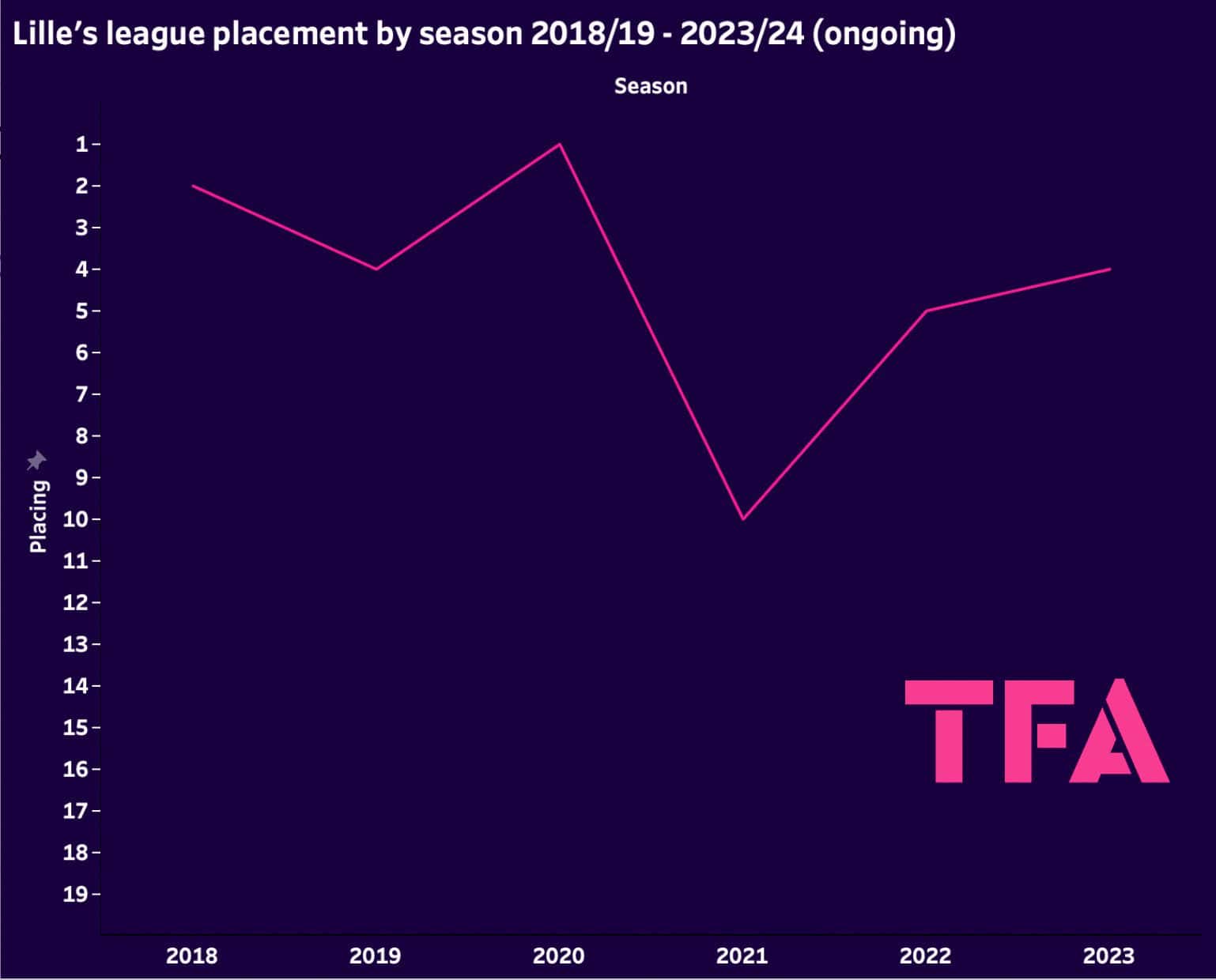
While Lille dropped to 10th during Jocelyn Gourvennec’s season as manager, they’ve bounced back well under Fonseca and achieved impressive results, considering the relatively young squad and the necessary nature of the transfer balance.
This article isn’t a tactical analysis piece, clearly, but an element of tactical analysis may be necessary when it comes to tying all the pieces of this article together — cohesion between owner/president, coach, players, recruitment, etc.
To recruit the best players, those players need to see your club as an opportunity. Unless you’re one of the biggest, final destination clubs, the kinds of young, promising prospects that Lille want to sign need to see players moving from your club and taking steps up the ladder; they need to see players coming to your club and thriving or, at least, doing better than they had been previously.
That’s precisely the environment Lille have created.
Take Angel Gomes, for instance, who took a chance on Lille just as Lille took a chance on him when he was on his way out of Manchester United.
After a season on loan at Boavista, Gomes returned and has since become a first-team regular in Ligue 1. He reinvented himself as a deeper midfield conductor and boosted his market value exponentially throughout his time at Lille.
Fonseca has been successful in implementing his preferred playing style on the club since his arrival at Lille.
Speaking to The Athletic, he explained: “The players have to know they will make mistakes, but I always insist they try. They know they can fail, but only within the intentions of the team. If it goes wrong, then it’s my fault.” He empowers his players to be brave and take risks, ensuring them they won’t be blamed if things go wrong as a result of his instructions, which he accepts is an inevitability.
Again, the clear communication of expectations is critical to the success of a process in the cohesive running of the club, and this time, it’s directly related to the on-field performance.
Fonseca has a clear way of playing that the recruitment department can rely on when scouting players for his team, and players can use it as a reference when they consider joining Les Dogues.
On arrival, the expectations are made crystal clear and assuming all other parts of the process are carried out successfully; those players will have a decent chance of succeeding.
Of course, you can never guarantee a player’s success at a new club, and Lille have had some misses over time, including during the last two years. However, a big bonus of the kinds of markets Lille deal in is that they don’t tie themselves into big-money contracts that no other club can match should a transfer not end up as positive as anticipated, and they can typically move these players on, either with a permanent transfer or a loan departure, quickly — meaning the player can try to relight their spark in a different environment and, crucially, the manager isn’t left with an out-of-form player he either has to play or has to disappoint every week.
All of this improves the optics around Lille as a destination.
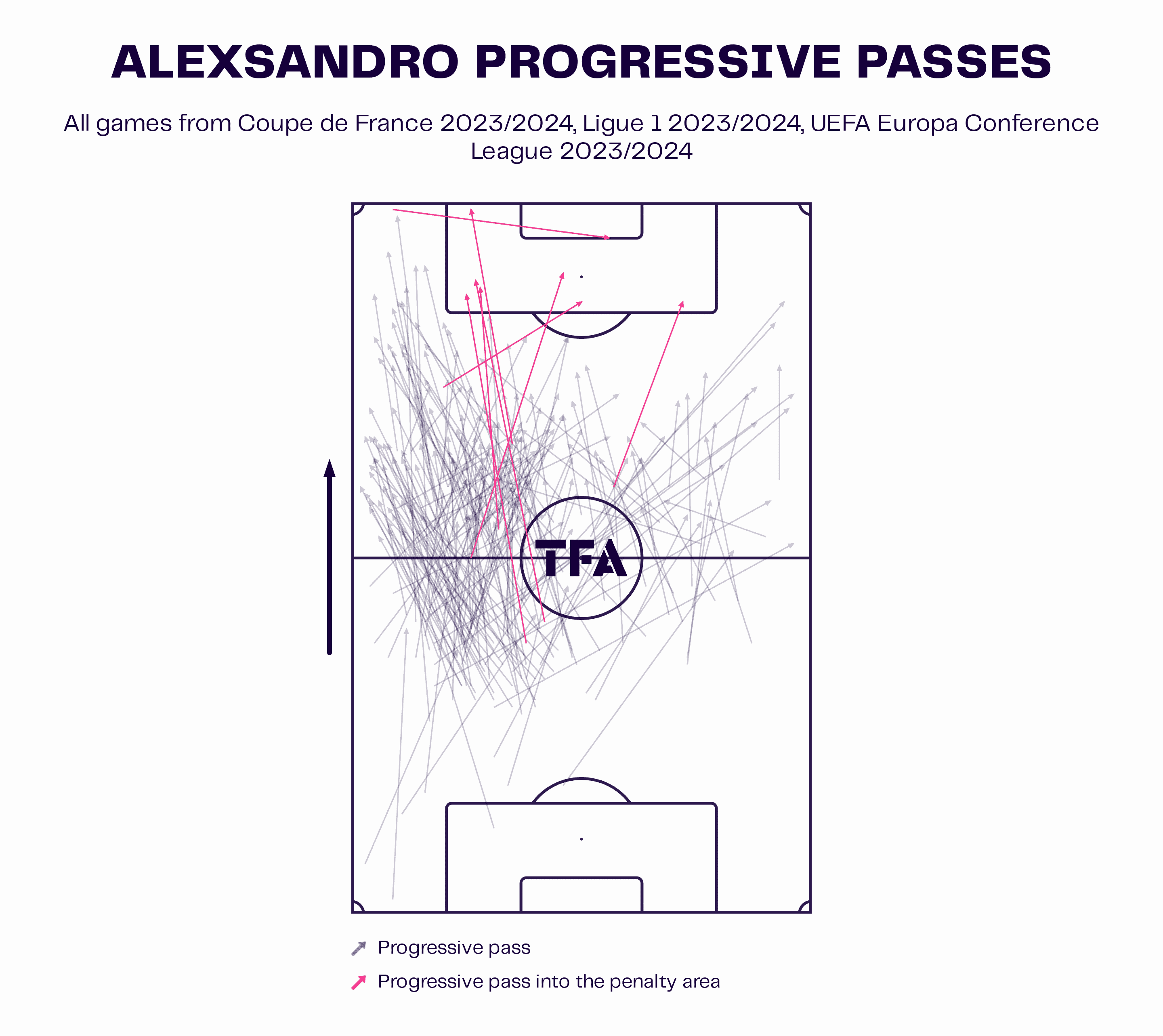
Lille have expressed bravery and risk-taking on the pitch in different forms over the past couple of seasons, one of which is progressive, line-breaking passes.
Alexsandro, signed from Portuguese club Chaves in the summer of 2022, has grown in reputation and value throughout his time at the club. He has played the most progressive passes (8.77 per 90) of any Lille player in Ligue 1 this term, with a 76.29% success rate.
The centre-back never hides on the pitch and looks to make himself an option for teammates to use during the build-up and ball progression phases frequently. He also doesn’t shy away from difficult passing options if he feels there’s a benefit there to taking that chance.
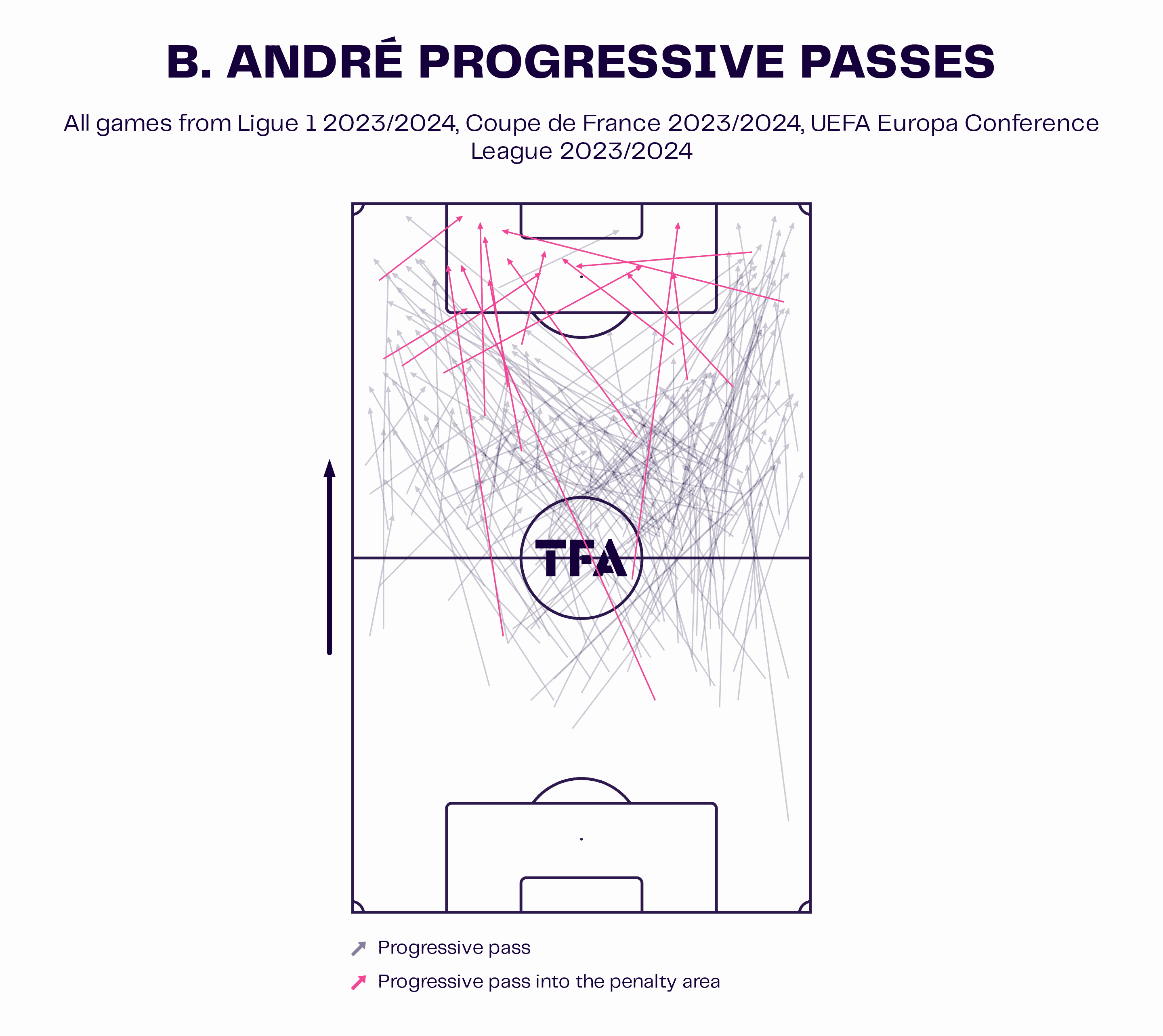
Benjamin André was a teammate of Sports Coordinator Sylvain Armand as a player and has become a vital figure in the Lille dressing room since making his 2019 move from Rennes.
Like Alexsandro, the current Lille captain, André plays a key role in his team’s ball progression. The 33-year-old operates from a deep-lying midfield position, where he likes to control the tempo and dictate play, again never shying away from taking responsibility on the pitch.
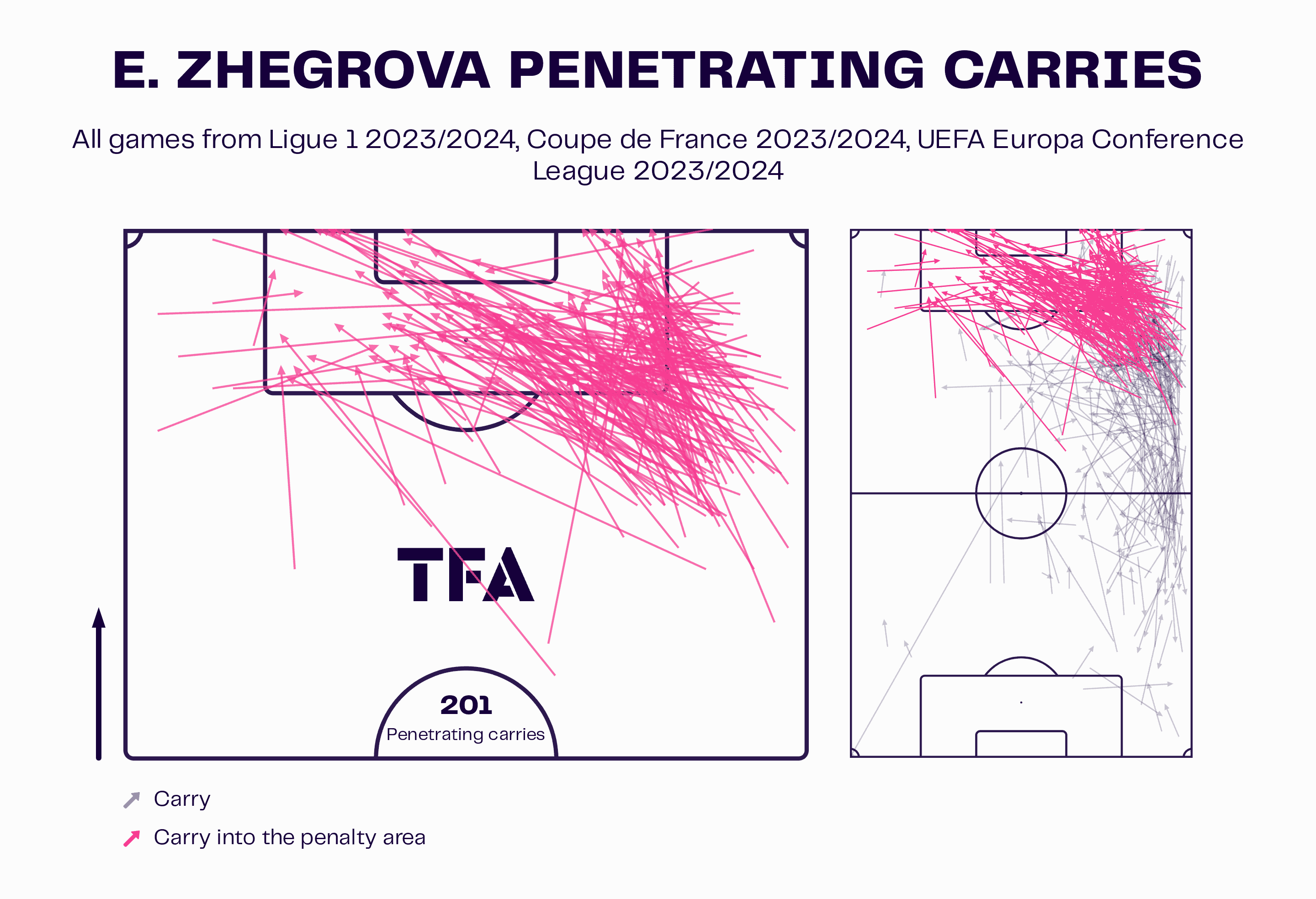
Edon Zhegrova joined Lille in January 2022 and has become a key figure further upfield for Fonseca than André and Alexsandro. The 24-year-old is a high-volume dribbler who’s completed 201 penetrating carries in all competitions so far this term, in addition to scoring nine goals and providing nine assists.
Fonseca can rely on Zhegrova to take responsibility and show personality in the final third, running at defenders and striving to drive his team into dangerous positions.
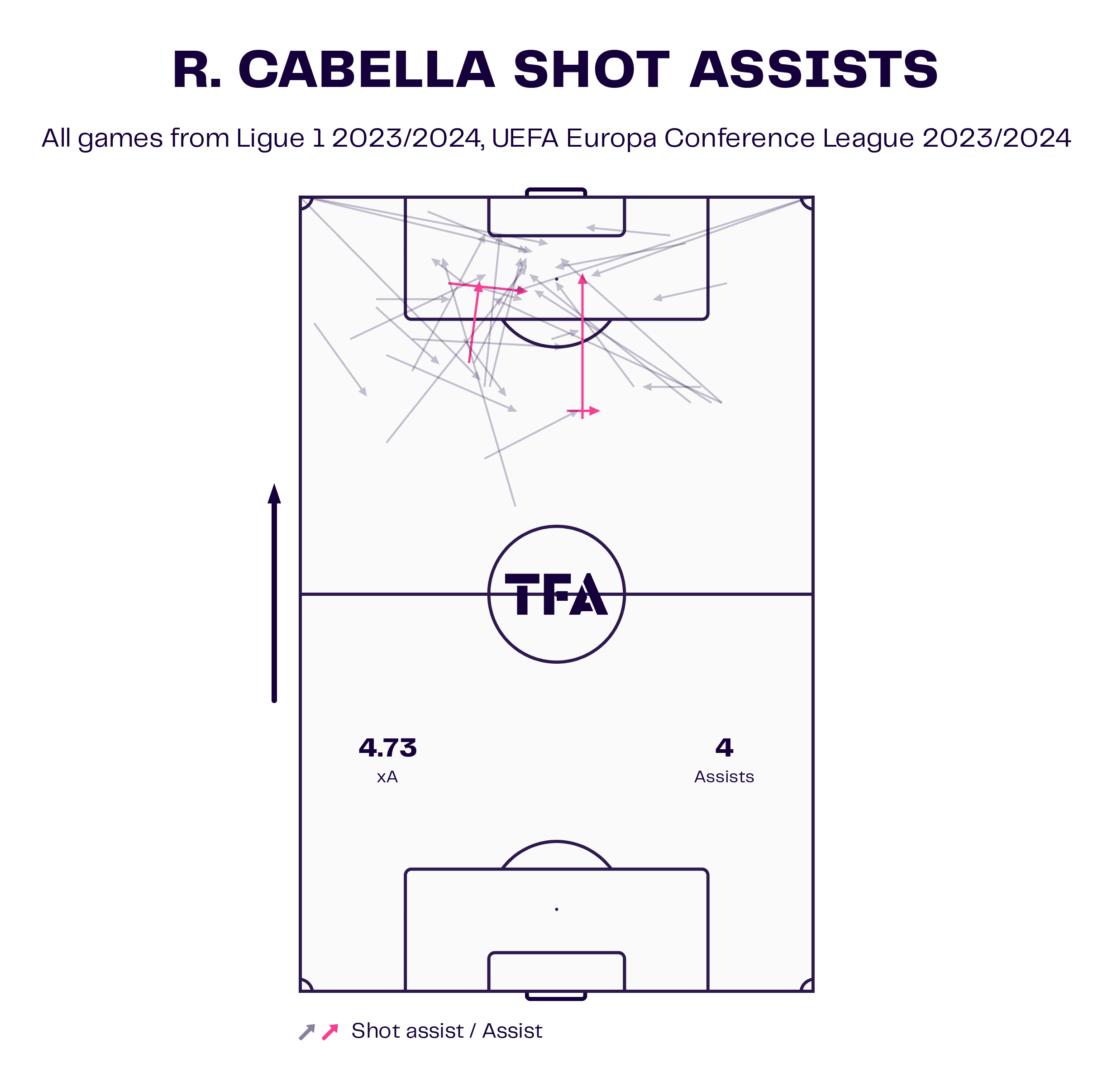
Lastly, Rémy Cabella joined Lille on a free transfer from Montpellier in the summer of 2022 and that has turned out to be an excellent bit of business, with the 34-year-old making 18 goal contributions last season on top of six so far this term.
Cabella is a crafty playmaker inside the final third capable of attacking space via intelligent off-the-ball movement. Thus, he makes himself an attractive passing option for teammates and takes it upon himself to try and set teammates up with incisive through passes—again exhibiting a form of bravery on the pitch and highlighting that it’s not just about attracting youth but also experience in the right places, which Lille have got right.
Conclusion
To conclude this analysis piece on Lille, the statistical, data and tactical analysis we’ve conducted here, all highlight symptoms of the effective, cohesive structure that’s been put in place at Decathlon Arena – Stade Pierre Mauroy.
In recent years, the harmonious relationship between all facets of the club, as analysed in this piece, has been facilitated largely by Sylvain Armand in his role as Sports Coordinator and given the ways in which Lille have achieved success in the different key areas for them, it’s difficult to say Armand has been anything but a success in that role, making Fonseca happy, the players perform well and increase their value, thus justifying the recruitment processes in place all the while youth is continuously being brought through from Lille’s productive academy — different parts of an effective ecosystem all thriving together as parts of a well-oiled machine.





Comments